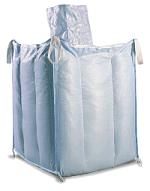In the article "High Speed Bulk Bag Filling - Preweighing", preweigh bulk bag filling systems, capable of achieving filling rates up to 40 bulk bags per hour, were described:
"Pre-weighing refers to weighing the payload of product to be placed in a bulk bag in a separate bin or hopper above the bulk bag filling machine.
Doing so eliminates the time required to precisely weigh the product as it flows into the bulk bag on the filling machine. Rather, the pre-weighed 'shot' can be dropped into the bulk bag as quickly as it can be made to flow through the pre-weigh hopper outlet."
In this article critical design considerations will be discussed.
Product Conveying Balance
A preweigh bulk bagging system capable of filling 40 bulk bag per hour must be 'fed' by the upstream production process and the system that conveys product to the bagging location, at the same rate - product in must equal product out.
This can be accomplished in two ways.
Often, the production line will continuously convey product to a large silo (50+ tons capacity). The preweigh bulk bagging system is located underneath the silo and bulk bagging occurs either continuously, if production can keep up with the bulk bagging rate, or periodically when production has filled the silo to an appropriate level.
A less common arrangement is where the production line can continuously match the bagging rate and product is continuously conveyed to the bagging line where it is continuously filled into bulk bags.
Weighing
Designing the weighing sub-system is the most challenging aspect of implementing a preweigh bulk bagging system.
As was shown in the previous article, a 40 bag per hour system has a total cycle time of 90 seconds. Of that, 15 seconds is allocated to emptying the preweigh hopper (the vessel wherein the product shot is weighed) into the bulk bag. From the preweigh hopper's perspective, the remainder of the cycle time - 75 seconds - can be used to weigh the next shot.
Assuming a typical dribble feed duration of 15 seconds, the fast fill portion of the weighing cycle is 60 seconds.
Typically, 50 - 100 lb of the total shot weight is dribble filled. That means that, in the case of a 2,000 lb bag, 1,950 lb of product must be metered into the preweigh hopper in 60 seconds. This equates to a very high instantaneous flow rate of approximately 117,000 lb/hr.
Two key factors must be considered to maintain accurate and consistent weighments:
- Flow control. The device used to meter the product into the preweigh hopper must be properly selected.
- Flow rate. The rate at which the product flows into the preweigh hopper must be consistent from bag to bag.
There are a number of ways to design such a weighing system according to the desired weighing accuracy and capital budget.
Note that preweigh systems can be designed to consistently maintain accuracy of +/- 2 lb.
Bag Stability
The faster bulk bags are filled the less time is available for densification. Further, bag stability becomes more of a concern as the bulk bag filling rate increases.
Applications with bagging rates over 20 per hour must be carefully assessed to determine what amount of densification is required to produce safe and stable packages.
As the bagging rate approaches 25 bulk bags per hour and beyond, stability and densification become a major concern with almost any product - particularly if stacking the bulk bags is a requirement.
In a preweigh system capable of filling 40 bulk bags per hour, the filling machine must be carefully designed to ensure the filled bags are stable and safe.
In the next article we will look at when a preweigh bulk bagging system should be used.
 Baffles are pieces of plastic fabric that are sewn vertically across each of the four corners of a bulk bag. The fabric pieces have holes in them so that product can flow 'through' them and fill the corners of the bag.
Baffles are pieces of plastic fabric that are sewn vertically across each of the four corners of a bulk bag. The fabric pieces have holes in them so that product can flow 'through' them and fill the corners of the bag.


